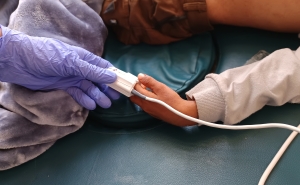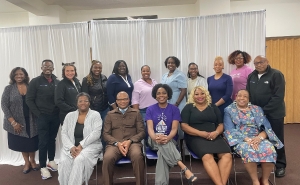A Conversation with the Experts on Ending the HIV Epidemic
“Ending the HIV Epidemic: A Plan for America”
At this year’s State of the Union address, President Trump announced “Ending the HIV Epidemic: A Plan for America”, an initiative that aims to eliminate new HIV cases in the U.S. within a decade.
If effective, the initiative would represent a public health success story that could serve as a model for the rest of the world.
“We have the science,” says Chris Beyrer, MD, MPH ’91, “but our biggest challenge is implementation.”
As moderator for a panel discussion of the initiative held at the Bloomberg School on November 22, Beyrer, the associate director of the Johns Hopkins Center for AIDS Research (CFAR) and Desmond M. Tutu Professor in Public Health and Human Rights, stressed three foundational truths to acknowledge in considering these challenges:
- New HIV infection rates in the U.S. have stubbornly plateaued since 2010. The first goal of the initiative is to achieve a 75% reduction in new infections within five years and a 90% reduction within 10. “That’s a very different goal than what we’ve had, and we are really going to have to engage with folks who are at risk of acquisition,” Beyrer says.
- HIV has always been and continues to be marked by health disparities. New rates of infection are clustered geographically across the southeastern U.S. (from Maryland to Texas) and among minority racial and ethnic groups. Across Appalachia and New England, an at-risk population has also emerged with the opioid epidemic and a new cohort of people who inject drugs.
- After more than 30 years, HIV infection remains a stigmatized condition. Stigma is a critical barrier to achieving the initiative’s goals. People living with the virus or who are at risk for it are also often in already-stigmatized groups, which leads to intersectional stigma.
Beyrer moderated the conversation between two people who play key roles in the Ending the U.S. AIDS Epidemic initiative: NIH’s Anthony Fauci, MD, who was one of the principal architects of the President’s Emergency Plan for AIDS Relief (PEPFAR); and the CDC’s John T. Brooks, MD, a nationally known expert on using public health research to improve the prevention and treatment of HIV infection and other diseases.
Watch the full conversation on C-SPAN
The two experts discussed both the science that makes it possible to end the epidemic, as well as the challenges to actual implementation.
The potential to end the HIV/AIDS epidemic comes from two proven sources, Fauci says: treatment and prevention.
Antiretroviral therapy has increased life expectancy exponentially since the 1980s—a “game-changing scientific advantage.” At that time, a 20-year-old newly diagnosed with AIDS could expect to live only one or two years. “Within a year, 50% of your patients are dead,” Fauci remembers. “Within two years, that’s 90%.”
Today, a newly diagnosed 20-year-old can expect an average of 53 more years of life—“nearly full life expectancy.”
Another game-changing advance, Fauci says, was realizing that treatment with ART also equaled prevention. The treatment helps reduce viral load to undetectable levels which, research showed, also meant the virus was untransmittable.
Prevention has also advanced with PrEP, or pre-exposure prophylaxis, a daily medication that can prevent people from contracting HIV from sex or drug use by 99%.
“Theoretically, if we accessed and put on antiretroviral therapy or PrEP everyone who has HIV and is potentially at risk, we could end the epidemic tomorrow,” Fauci says, echoing Beyrer’s statement: “We have the science.”
What stands in the way is a treatment gap of 14.6 million people.
Fauci highlighted some demographic and geographic concentrations of vulnerable populations:
- 43% of all new HIV diagnoses are among African American men (who comprise just 13% of the US population).
- 60% of all new HIV diagnoses are among men who have sex with men.
- Just 38 counties plus Washington D.C. and San Juan account for more than 50% of all infections in the U.S. To put this number into perspective: that’s “40 out of 3,007 units have 50% of the population of people living with HIV,” Fauci says.
Reaching all those at risk will require developing new and improving existing methods of treatment and prevention. One solution is to find ways to make ART more accessible and/or long-acting. Receiving an injection every few months, for example, is much easier to manage than taking a daily pill.
“We have enormously effective toolkits for prevention and treatment,” Fauci says, “but we need to maximally utilize and implement them and they need to be user-friendly.”
After Fauci’s presentation, John Brooks discussed both challenges and opportunities for putting the initiative’s plan into action.
Infection rates, which were declining, have stalled since 2010 with two key drivers: First, the opioid epidemic has led to a resurgence of injection drug use; second, and perhaps harder to combat, is complacency.
“People think this issue is resolved in the U.S.,” Brooks says. The resulting inertia is an obstacle to diagnosing all people with HIV as early as possible—a critical component to stanching the epidemic.
Those who are diagnosed early and start—and stay on—ART have no risk of spreading the infection. But over half of all people newly diagnosed with HIV have been living with the virus for three years before diagnosis, Brooks says, during which time they may have passed the infection on to others.
Brooks suggests a number of opportunities to improve diagnosis rates, including automatically testing for HIV in clinical settings, repeat-testing strategies for at-risk populations, and expanding access to testing to “meet people where they are” including making use of advancements in self-testing technology.
“If we are doing it right, you will first see an increase in HIV diagnoses before you see a decrease in incidences,” Fauci says, “because we’re testing more people.”
Keeping people on ART is another challenge. A daily pill is problematic for people who are prone to “highly disorganized lives,” such as those with mental health or substance use disorders or who are incarcerated. Routine care is a challenge for those whose work schedules conflict with clinic schedules.
Brooks and Fauci emphasized that we must confront these challenges—and now is the time.
“The HIV epidemic has cost America too much for too long,” Brooks says. More than 700,000 Americans have died since 1981, and the disease has cost the U.S. over $28 billion.
“Without intervention, and despite substantial progress, another 400,000 Americans will become infected—if we do nothing.”
Advancements in technology and implementation have made it possible to end the epidemic. Dedicated federal funding through the initiative will help spur innovation and surveillance. Now, there is a chance to match the science with renewed urgency and support.
The CDC has highlighted Baltimore as a municipality to receive funding for implementing programming, PrEP, testing, social media campaigns and an array of other activities around ending the HIV/AIDS epidemic. The Center for AIDS Research will play a significant role in implementation science with the initiative.
Several organizations are working together on the initiative, including the Health Resources & Services Administration, the NIH, the CDC, the Indian Health Service, Substance Abuse and Mental Health Services, the Centers for Medicare & Medicaid Services, and the Department of Health and Human Services.
RELATED
“What would it take to end the HIV Epidemic in the U.S. by 2030?”—Hopkins Bloomberg Public Health Magazine
“The Early Days of the World’s Longest-Running AIDS Cohort Study”—Hopkins Bloomberg Public Health Magazine





